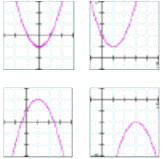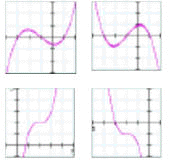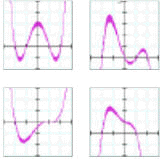|
Recognizing Polynomial Equations from their GraphsA polynomial equation is any equation that has an equation of the form: y = c0 + c1·x + c2·x2 + ... + cn·xn where the powers of x must be integers. The letters c0, c1, … , cn represent numbers. The largest power of x in the polynomial is called the degree of the polynomial.
Finding a Formula for a Polynomial EquationFinding a formula for a polynomial equation using regression on a calculator is a two-step process. The first step consists of deciding which type of regression to use, and the second step consists of actually carrying out the regression on a graphing calculator to find the formula. Recognizing a Polynomial from its GraphEach of the different types of polynomial equations has a distinctively shaped graph.
Table 1: Equations and typical graphs for polynomial equations of order zero to four. |
| Copyrights © 2005-2024 |






